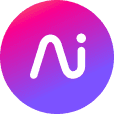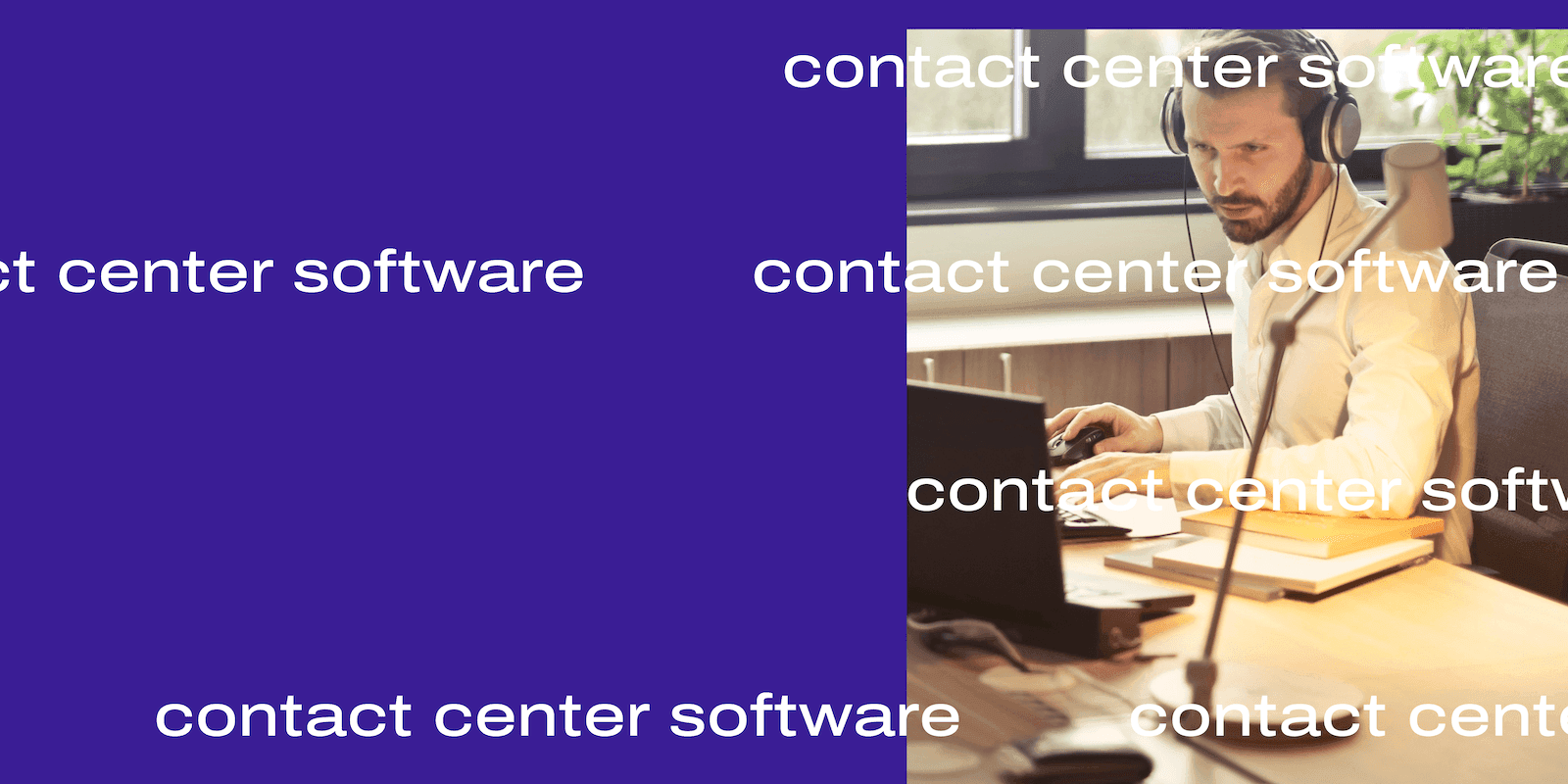
Tags
Share
If you’ve landed on this blog, welcome! I’m going to be honest about two things up front—not every business needs contact center or call center software. (Not even every business that cares about customer experience needs contact center software.)
But if your business gets a decent volume of inquiries (or has to do lots of outreach) on a daily basis, whether that’s over the phone or through live chat…
And you’re finding that your agents or reps are becoming overwhelmed by all those communications…
Then yes, you probably need some kind of hosted call center software solution.
The second thing is that of course, you’re reading this on Dialpad’s blog. (Spoiler alert: We built a contact center product. It’s pretty awesome. We have ecommerce businesses, small businesses, customer service teams, sales teams—you name it—that love using it.)
Which means that yes, Dialpad's cloud contact center platform is going to be on the list below. But hey, our competitors have very similar blogs, with very similar lists, about this very topic. And you can bet they’ve got their product at #1 on the list too.
So why should you bother with this list? What makes it different?
Well, I’ve just told you what the game is with these blogs, and I’ll also tell you, objectively, why Dialpad is on the top spot of the list.
As the title mentioned, this list of the best contact center software is ranked by ease of use, and I’m going to show you specifically how and why Dialpad is easy to use.
After listening to countless call recordings with customers and interviewing them for customer stories—some of which I’ll include later as well—we truly believe we have a solid case for why Dialpad is the best contact center software for folks who are looking for something that’s easy to use, adopt, and admin.
I won’t feed you any copied-and-pasted word salads about “top features” or insult your intelligence by saying that Dialpad is “The Best Contact Center Platform for EverySingleBusiness.”
Instead, I’m going to show you, literally (and visually) how to do everyday supervisor and agent tasks in Dialpad and what that looks like in the software. You can decide whether that's interesting enough for you to check it out.
What is call center software?
Call center software is a type of software that lets businesses handle a large volume of phone calls using a computer or mobile device. Usually, these are phone calls with customers and prospects. Besides facilitating phone calls, these solutions will often come with other communications features, like the ability to record calls, forward calls, and coaching features (like letting a supervisor barge the call).
Types of call center software
On-premises
As the name suggests, on-premises call center software (on-premises providers tend to be a bit more old school, then many are still more call center-focused) operates on equipment housed in your office space. Probably in a storage closet. Max, our own in-house telephony wizard, wrote about the differences between on-premises and cloud solutions here.
But essentially, on-premises options tend to use traditional phone lines and require you to have a ton of server closet space—plus an in-house IT crew to manage all the installation, maintenance, and upgrades.
You do have more control over every single tiny detail of your contact center setup, but the high upfront cost of on-premises solutions isn’t usually a great option for small businesses or organizations that want to be smart with their budgets.
And if you want to scale your contact center up or down when high or low season hits, it’s generally much, much more difficult to add physical phone lines and users. It also makes it harder for your agents or supervisors to work remotely.
Cloud-based
On the other hand, with a cloud-based solution (aka. CCaaS, or Contact Center as a Service, solution)—the big advantages are of course, pricing and flexibility.
Almost all cloud contact center software will charge you on the SaaS model, meaning the software is maintained by your vendor while you pay for the service on a monthly or annual subscription basis.
Businesses tend to like this for two reasons:
The vendor will take care of updates and support, so you don’t need to fork out for maintenance costs.
The pricing is more flexible and there’s no hardware required, which means you don’t have huge upfront costs
Call center software features not enough? You may need a contact center solution
Think of contact center software as a more advanced version of call center software. The main difference is that it lets you handle high volumes of communications through a range of different channels including video meetings, SMS text messaging, social media messages, live chat, chatbots, and more. And contrary to what many people think, this goes beyond your average customer interaction and outbound sales campaign.
👉 Important side-note:
In general, cloud solutions are more flexible and cost-effective than on-premises solutions, true, but not all cloud solutions are equal. For example, even though you can add users with a click and spin up a new contact center team in a few minutes with Dialpad, that doesn’t mean this workflow is just as easy with all other cloud or virtual call center platforms.
The 12 best contact center software solutions: Ranked by ease of use
1. Dialpad Ai Contact Center
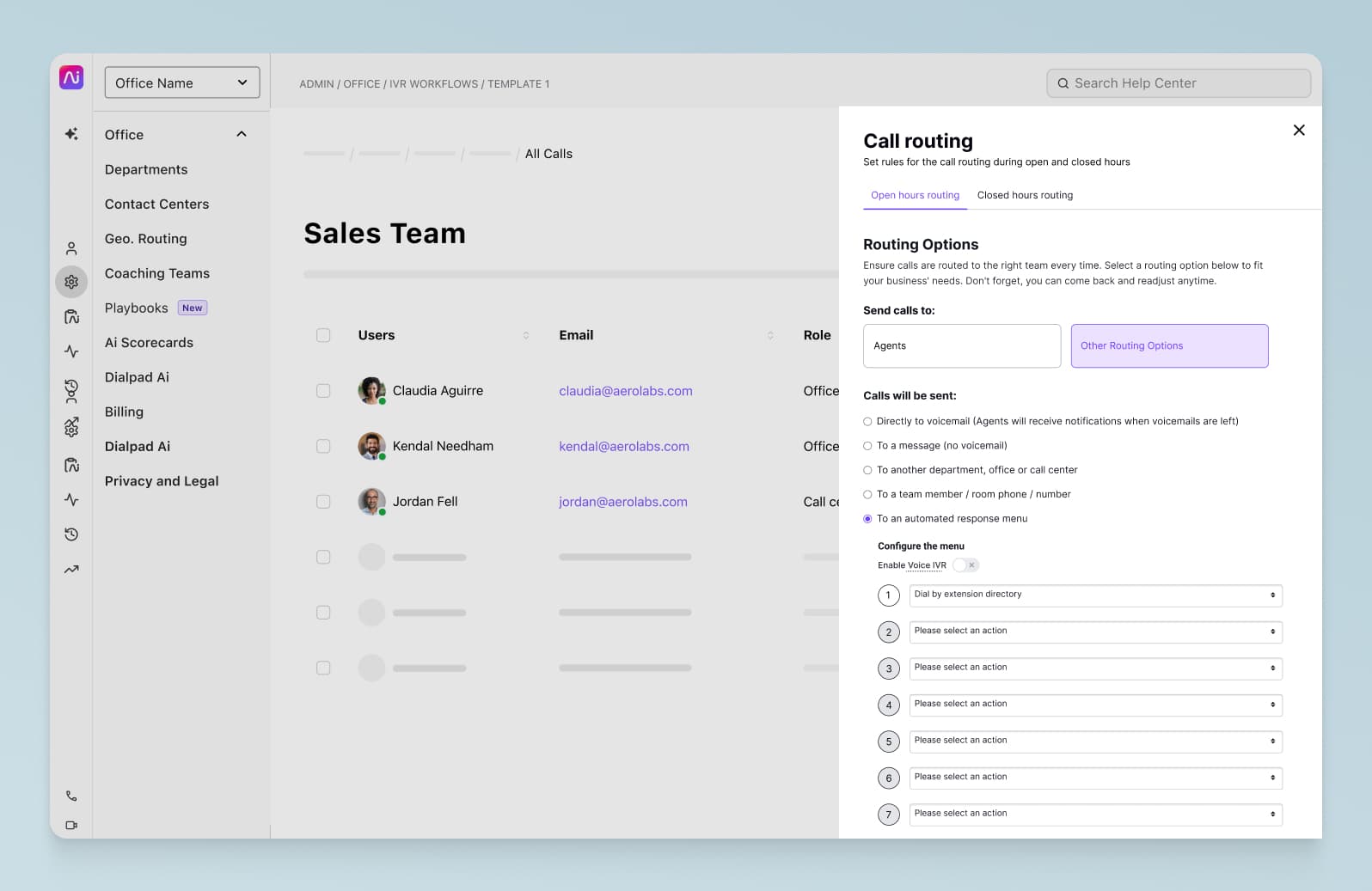
👉 What customers think:
“One thing that I love in Dialpad is the call journey feature, where you can see where calls were routed, forwarded, and changed. It’s beautiful, and brought a lot of peace of mind to our call center operations—there’s no more wondering where a call came from or how someone got it.” - Sahil Farooqi, Head of Customer Care, Rently
Whether you need to support a customer service team or sales team, or any other inbound or outbound contact center team… Dialpad really does lead the pack in terms of ease of use.
(Along with 24/7 customer support on email, chat and phone on the least expensive plan—which is rare for all contact center solutions.)
You can also set up in-queue callbacks so that customers don’t have to wait on hold:
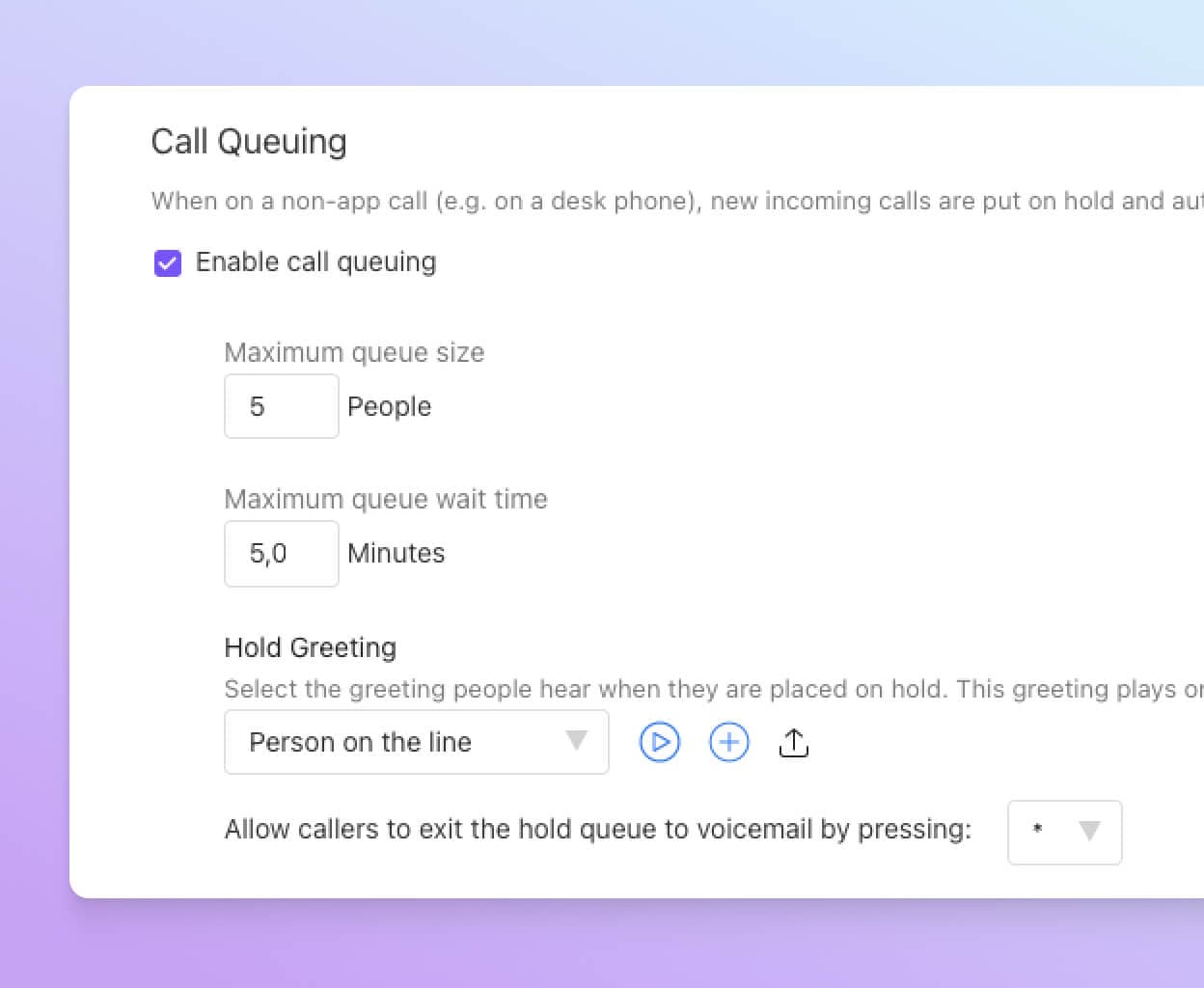
(Want to create CSAT surveys? You can do that too with two clicks.)
On top of that, Dialpad also has a desktop and mobile app that works across iOS, Android, PC, and Mac, which means agents and supervisors can work from their mobile devices on the go too.
And so on and so on… But really, those are just table stakes. Those things should be simple to do in your contact center software.
What really sets Dialpad apart are the things you don’t expect. Like its artificial intelligence.
Industry-leading AI
Dialpad Ai is Dialpad’s proprietary artificial intelligence technology, which at its core, transcribes calls (and voicemails!) in real time—more accurately than almost all competitors out there:
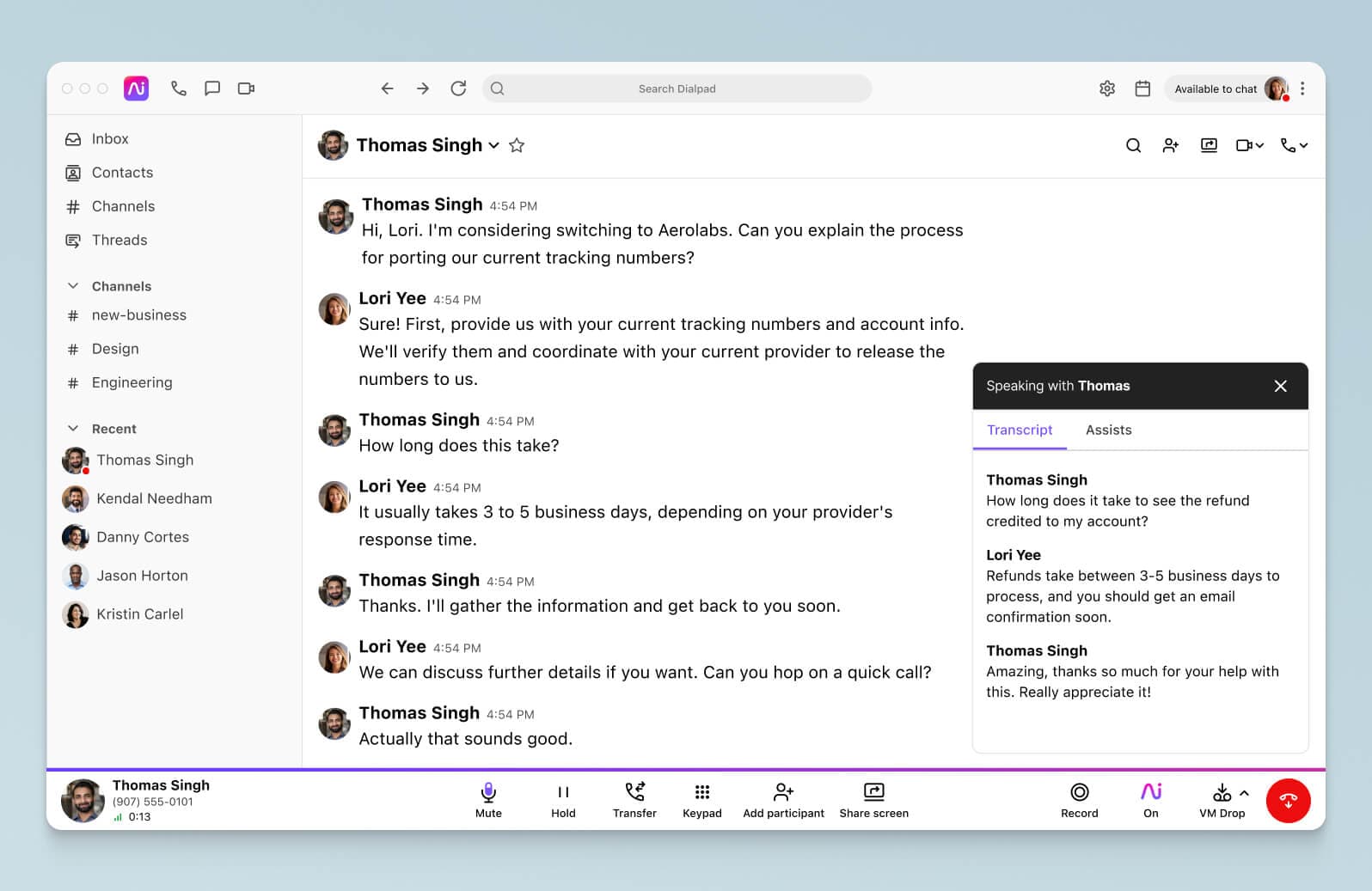
Beyond just transcribing calls, Dialpad Ai can also help contact center teams track keywords that come up often on customer calls. For example, a sales team might want to track how often a competitor’s name comes up, while a customer service team might want to track how often complaints about a certain feature gets mentioned.
In Dialpad, you can create “Custom Moments” to track these keywords and phrases:
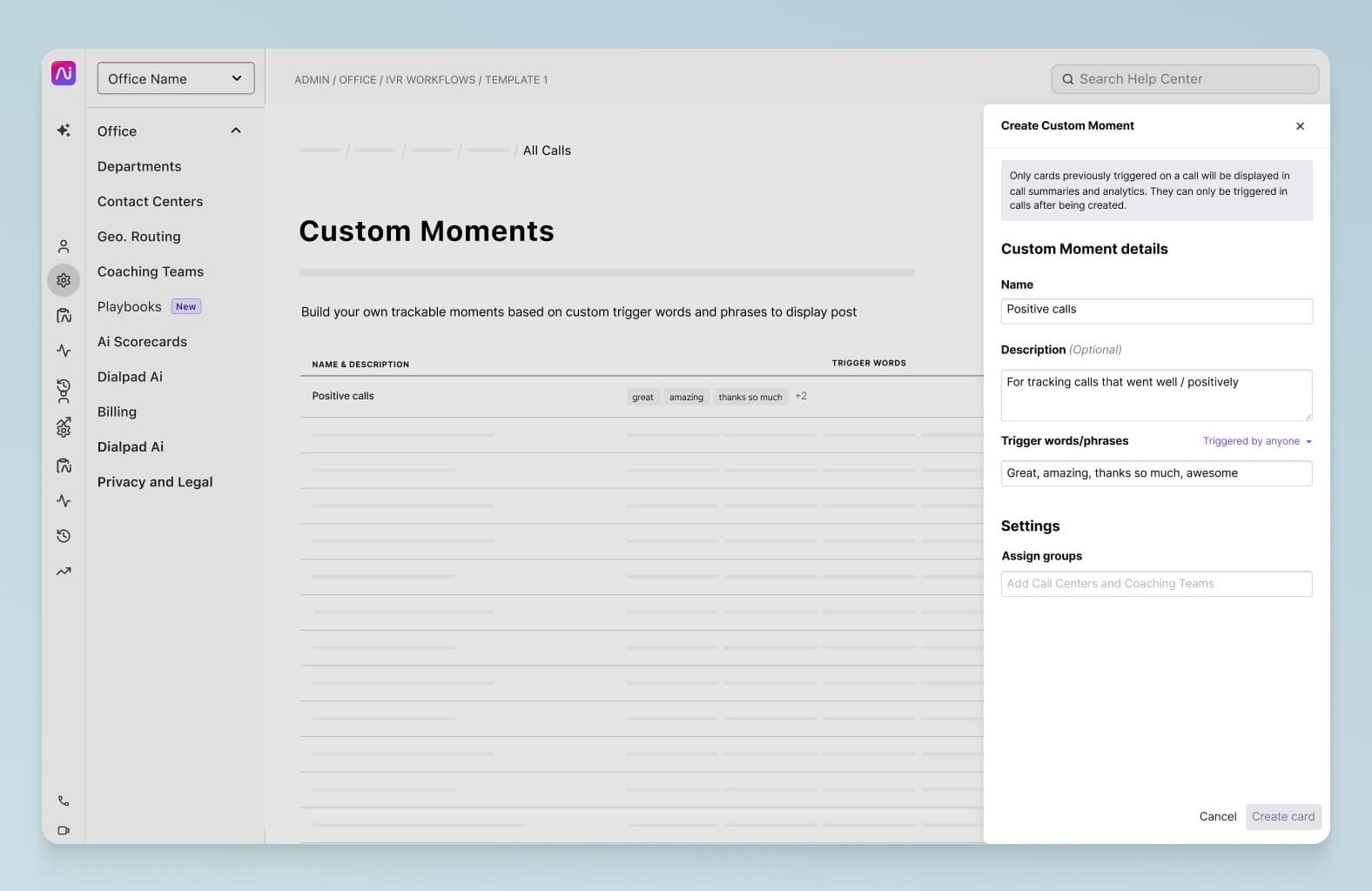
Supervisors can even go one step further with Dialpad Ai and create Real-Time Assist (RTA) cards, which are a whole new way of looking at scripting. RTA cards are essentially tailored notes about specific topics that pop up automatically on agents’ screens—when those topics come up on calls. For example, if new agents aren’t familiar with all your pricing packages, you can create an RTA card with notes on pricing and set it to trigger when “cost,” “price,” or “pricing” are said on a call.
It’s like automated coaching—on a massive scale:
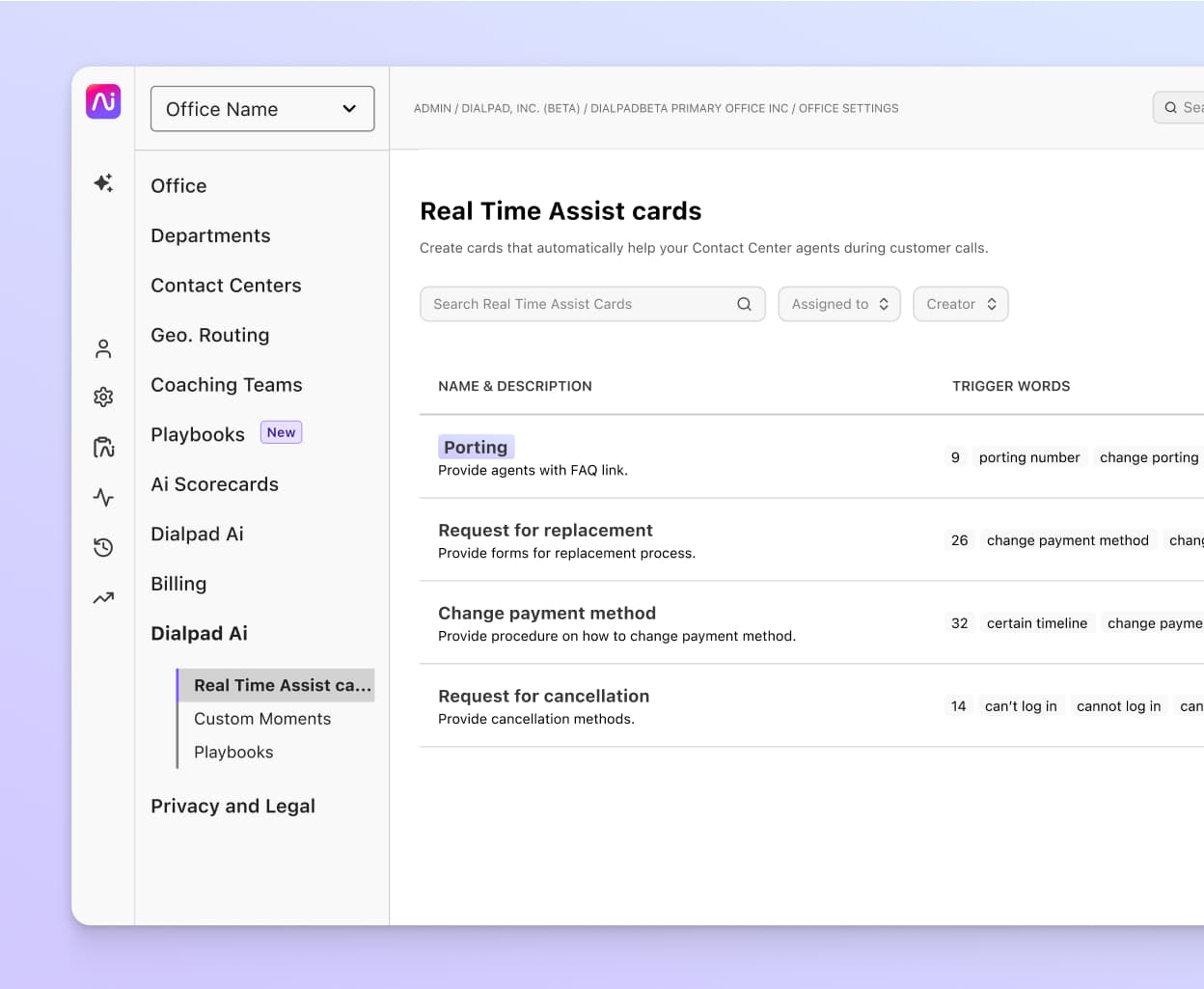
Truly unified communications channels
Again, the great thing about Dialpad’s contact center solution is that it’s actually an integrated part of the wider communications platform. That means all your communication channels (VoIP business phone system, instant messaging, SMS/MMS, video conferencing) are all in one place. No need to toggle back and forth between different accounts or user interfaces.
And then there are the little things too, when it comes to communications. For example, a big time-saver for outbound call center teams is the voicemail drop feature, which lets sales reps record a voicemail message and “drop” it into a call if the prospect doesn’t pick up:

For sales teams that have to make hundreds of cold calls a day, this can add up to hours saved every week.
Why both small businesses and enterprises love Dialpad Ai Contact Center
For small businesses (we’re talking less than 50 agents) Dialpad is incredibly easy to use, and it’s important to note that this size of business has historically been priced out of contact center software. Dialpad is affordable and flexible enough that it makes sense as an investment for small business call centers.
For enterprises, on the other hand, none of this changes—but there’s also a 100% uptime SLA on the Enterprise plan, so you don’t need to worry about glitches or downtime affecting your customers.
The other thing that businesses of any size love about Dialpad is all the integrations with popular apps. There are the CRM integrations like the ones with Zoho CRM, Salesforce, and HubSpot, which automatically log activities and embed a CTI dialer right inside them to let agents make phone calls directly from the CRM:

Want to build your own custom contact center integrations? You can do that too with the API.
Interested in an integrated cloud contact center solution?
Dialpad’s contact center platform gives you VoIP calls, video conferencing, SMS/MMS messaging, instant messaging—and contact center features—in one platform.
See how Dialpad Ai Contact Center works
Check it out, dig into the unique Ai-powered features, and learn more about pricing info. Book a demo, or take a self-guided interactive tour of the app on your own first!
2. Talkdesk
Talkdesk is also a well-known contact center platform. It has most of the features you’d expect, including call queuing, ACD, and IVR in addition to agent performance and workforce management tools. (Get a closer look at how Talkdesk compares to Dialpad.)
Reviews on third-party sites say that it's user-friendly and that integrations work well, and as one of the more modern cloud solutions, Talkdesk's user-friendliness is up there, so it's high on this list. But, there have been reported issues with slow-running screens and poor call quality—plus sometimes glitches with logging calls and reporting.1
A few of the features you get:
Omnichannel routing using their “Talk Studio” routing designer
Real-time dashboards
API access
Integrations and app marketplace
Pricing: The most basic package, CX Cloud Essentials, is $75 per user per month, going up to $95 for Elevate and $125 for Elite2 (which gets you a 100% uptime SLA), with yet another tier above that. If you want Agent Assist tools and customer experience analytics, you’ll have to pay extra for an add-on at Elite level.
👉 Quick tip:
Dig deeper into how the best solutions stack up against each other in this cloud contact software comparison.
3. Aircall
Aircall is another cloud-based phone system and outbound / inbound call center software. It's not quite an omnichannel or multichannel contact center—although it does include business SMS.
It’s considered to be pretty easy to use, but some problems have been reported around call quality and a long wait for customer support. There’s no automated voicemail function, and reviewers also mention that a few features aren’t as intuitive as they could be.3
A few of the features you get:
Outbound and inbound calls
Call distribution / routing options
Integrations and API access
Call recording
IVR
Voicemail
Pricing: The Essentials tier will cost you $30 per user, per month. Next up is Professional for $50, which adds call monitoring, power dialer, and in-queue callback.4 For custom analytics and access to API developer support, you’ll need to get a custom quote. (Learn more about the best Aircall alternatives.)
✒️ Vetting contact center solutions?
This RFP checklist covers the essentials to be aware of as you're shopping for a contact center platform.
4. Five9
Perhaps best known for its almost-acquisition by Zoom, Five9 is a contact center solution that has the fundamentals that you’d expect like CRM integrations and workforce optimization tools.
Five9 does have a mobile app, but word is that it’s not great—which isn’t ideal for virtual contact centers where agents are working remotely using their own devices. Some online reviews cite a steep learning curve, plus a few connection issues.5
A few of the features you get:
Predictive dialer
Call recording
Real-time reporting
Pricing: You can get in touch with the company for a quote for their Core, Premium, Optimum and Ultimate bundles. It does look like a number of features (Agent Assist, IVR, SMS and video, CRM integrations) are priced separately as add-ons.6
🤿 Deep dive:
Get an in-depth look at Five9 vs Dialpad Ai Contact Center!
5. Avaya
Compared to the other cloud call center software on this list, Avaya has been around for a while, since the on-premises days, which puts it at a bit of a disadvantage when it comes to ease of use.
Some users have experienced issues with slow running, glitchy audio and dropped calls.7 That being said, it has most of the basic features you’d expect like intelligent routing, and is actually not as painful to use as some other on-premises solutions—once it’s set up. (Which is why it made the list.)
A few of the features you get:
Digital channels like email, web chat, text messaging
Self-service tools
Visual workflow orchestration
Pricing: Pricing tiers are divided into Digital ($41 per user, per month), Voice ($71), All Media ($106), or Create Your Own (custom).8 You can choose whether you want to operate just a call center or a multichannel contact center. (Learn more about the best Avaya alternatives.)
6. Freshdesk Contact Center
Freshdesk is part of the Freshworks telephony stable, and was formerly known as Freshcaller.
There’s also another option on the Freshdesk website that’s named slightly differently and lets users choose between “Support Desk” and “Omnichannel Contact Center” solutions. It’s a bit confusing—which doesn’t get you started on the right foot when it comes to ease of use—so if you’re interested, you can feel free to dig into all the different plans there.
Freshdesk's call center software has been praised for its gamification features and scenario planning tools, but there are complaints about inconsistency, customer service, and helpdesk ticketing systems.9
A few of the features you get:
All Support Desk features
Omnichannel dashboard
Chatbot builder and analytics
Contact management
Marketplace apps
Automation
Ticket, conversation, and call reports
Time tracking
Pricing:
Support Desk: Free—but charges by the minute for calls; Growth ($15 per user, per month); Pro ($49); Enterprise ($69)10
Omnichannel: Growth Omnichannel ($29 per user, per month); Pro Omnichannel ($59); Enterprise Omnichannel ($99). It’s probably best to reach out to them if you’re interested to clarify the difference between the discrepancies on their web pages.
7. Twilio Flex
Finally, Twilio Flex is a cloud call center software that lets you tailor the solution to your own needs. Or rather, it lets your developers do it, since Twilio is a very tech-heavy developer-focused tool.
If you have the team to do it, Twilio is a good solution, which is why it’s on the list, but because it requires such technical expertise, it’s low on the list.
The website advertises that you can go live in five days (that’s a tad longer than Dialpad’s two minutes, probably because it’s quite complex to set up). If you do have the time and the IT resources, you can build a bespoke omnichannel contact center with custom metrics and reporting.
The pricing model, which is a little different from other cal center software, makes it a scalable solution. However, quite a few people say the customer support could be improved.11 (And you’re likely to need it while you get the contact center setup just right.)
A few of the features you get:
Intelligent routing
Customizable workflows
Integrations and APIs
Reporting and dashboards
Pricing: You can choose to be charged per hour ($1 per active user hour) or pay a monthly flat rate of $150 per named user (agent, supervisor, administrator). There’s a free trial that Twilio says gives you $5K worth of active user hours, although it doesn’t include certain features such as insights or self-hosted UI.12
8. LiveAgent
LiveAgent is a call center software comes with a helpdesk solution, which integrates different communication channels into one inbox. The main thing to remember here is you only get email and live chat as the channels that agents can handle—if you want true omnichannel functionality, LiveAgent won't give you that.13
LiveAgent has a huge array of options and features, which may be overwhelming (and inefficient, cost-wise) for smaller operations.
A few of the features you get:
Automated routing
Screen sharing
Ticket management
Collaboration tools
Pricing: Starts at $9 per agent per month14
9. Vonage Contact Center
Vonage is a pretty well-known communications solution with roots in residential telephony. Today, it has a business phone system product and also a contact center offering.
It’s a decent low-cost option for small businesses that have relatively simple needs. Although it isn’t as feature-rich as some of the other options on this list, it does have your basics like IVR and call routing.
A few of the features you get:15
Screen pops
Call recordings
Skills-based routing
Analytics and reporting
Pricing: You'll have to contact them to get a quote
10. GoTo Connect
You’ve probably heard “GoTo Meeting” more than “GoTo Connect,” but these are essentially a video and audio conferencing solution that’s part of LogMeIn’s suite of products.
Even though it's primarily known as a UCaaS solution that includes a mobile phone app, call forwarding, and an auto attendant—basically a cloud phone system that includes other communication channels—there isa Contact Center add-on.16
A few of the features you get:
Voice, video, chat, SMS, social channels
Call analytics
Outbound dialer
Pricing: Starts at $27 per user per month, but you have to contact their Sales team for a quote to get contact center pricing.17
11. CloudTalk
Cloudtalk is a VoIP call center provider that is another good budget alternative for companies with relatively simple needs. It features a predictive dialer for the convenience of your agents, as well as call monitoring features so that supervisors can provide live agent coaching. Again, you don't get omnichannel functionality like video conferencing or team messaging.A few of the features you get:
Click-to-call
Automated call distributor
Mobile app
Pricing: Cloudtalk starts at $25 per user per month.18
12. UJET
UJET is a relatively new player in the contact center space that's does provide more of an omnichannel customer experience, so it’s worth checking out if you’re looking for a platform to bring all your different channels together.
A few of the features you get:
Embedding mobile app
Allows customers to share photos and videos in chat
Integrates with popular CRM
Pricing: Starts at $65 per month19
A few essential things to look for when choosing between contact center providers
Easy call routing
This is a must-have for any contact center software, so really, if the options you’re looking at don’t have an inbound call routing, they shouldn’t even be on your list.
The thing to pay attention to here is how easy it is to set up and make changes to your call routing. Do you need to contact tech support or wait a few days (or weeks) for them to implement the changes?
Or can you just change your call routing options with a few clicks in your online dashboard—like in Dialpad?
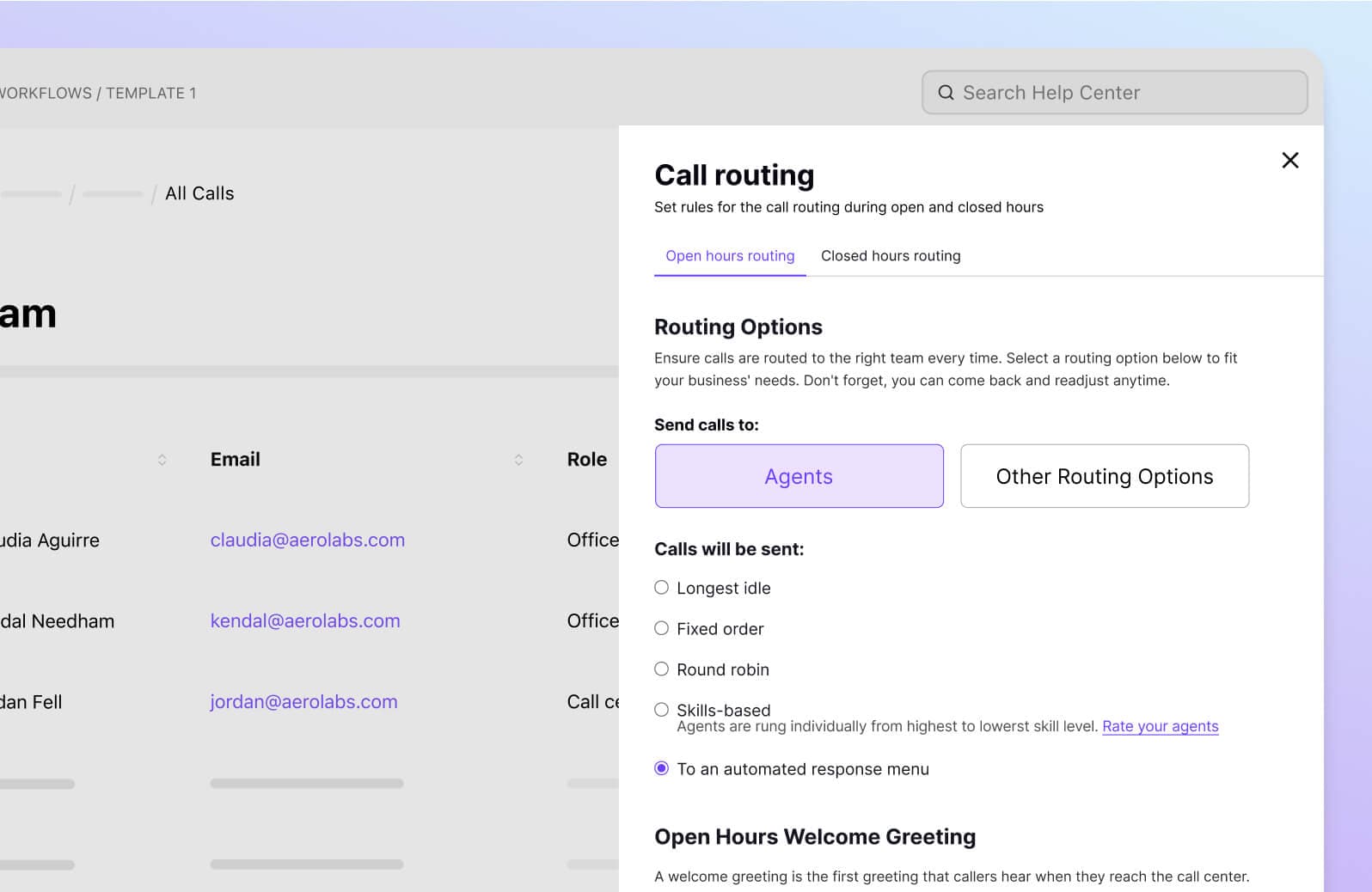
Unless you’re at a company that lets years go by between making updates to your IVR (Interactive Voice Response) or ACD, this is an especially important feature to look for. It should be easy to streamline that call flow and let your callers self-service or route themselves to the right agent or department—without your team having to lift a finger.
Bottom line: Every contact center or call center software should have a routing feature. But the best call center software will make it easy for any contact center supervisor to do this, with no IT help.
"You just add a person’s name and email, choose the phone number, and you’re done," says Zak, President of Service Today.
Clear call quality
This one is often overlooked, but essential. In fact, a huge number of Dialpad’s contact center customers switch to Dialpad—because of the better call quality.
Let’s face it. You can’t even get into “customer engagement strategies” or “customer satisfaction tactics” if you’re dropping incoming calls left and right, or if your prospects can’t hear your sales team’s pitch because they keep cutting in and out.
And with some cloud contact center software, you can also easily add and remove users with a click, so that you’re only paying for the licenses you need. (Yes, I’m talking about Dialpad.)
👉 Fun fact:
Dialpad’s unique dual-cloud architecture and global voice network are designed to give you excellent call quality, all over the world. And for our Enterprise plan customers, we even guarantee 100% uptime. Not 99.99, not even “five 9s.”
TL; DR - If your contact center team is heavily call-focused, then you’ll need software that gives you HD-quality calls.
Integrations with the tools you’re already using
Whether it’s a CRM (customer relationship management) tool or help desk software, your contact center software should have a decent range of integrations to streamline those workflows and minimize the need for agents and supervisors to constantly flip back and forth between different tabs or windows.
Dialpad, for instance, has a variety of CRM integrations with tools like Salesforce, HubSpot, Zoho CRM, and more. Not only do these integrations embed Dialpad’s CTI dialer right inside those tools so that agents can click-to-dial directly from there, they also automatically log calls and activities:

(And if you need an auto-dialer or power dialer, Dialpad’s got that too.)
Real-time analytics and dashboards
Measuring the performance of your contact center in real time is, for most supervisors, a must-have, because if an issue comes up, you want to be able to address it in real time.
The thing to look for here is built-in, real-time analytics. Some contact center solutions don’t have good embedded analytics and require you to contact their support team to get that data pulled (and some providers also charge you per support ticket submitted, so watch out for that). Sometimes, these requests can take hours, days, or if you’re unlucky, weeks.
That’s why having those metrics visible right inside an online dashboard is preferable—it streamlines that whole data gathering process for supervisors and leaders.
For example, Dialpad’s contact center platform has built-in dashboards that show metrics like abandoned calls and missed calls, and also heat maps that show you call volume patterns and even average speed to answer:
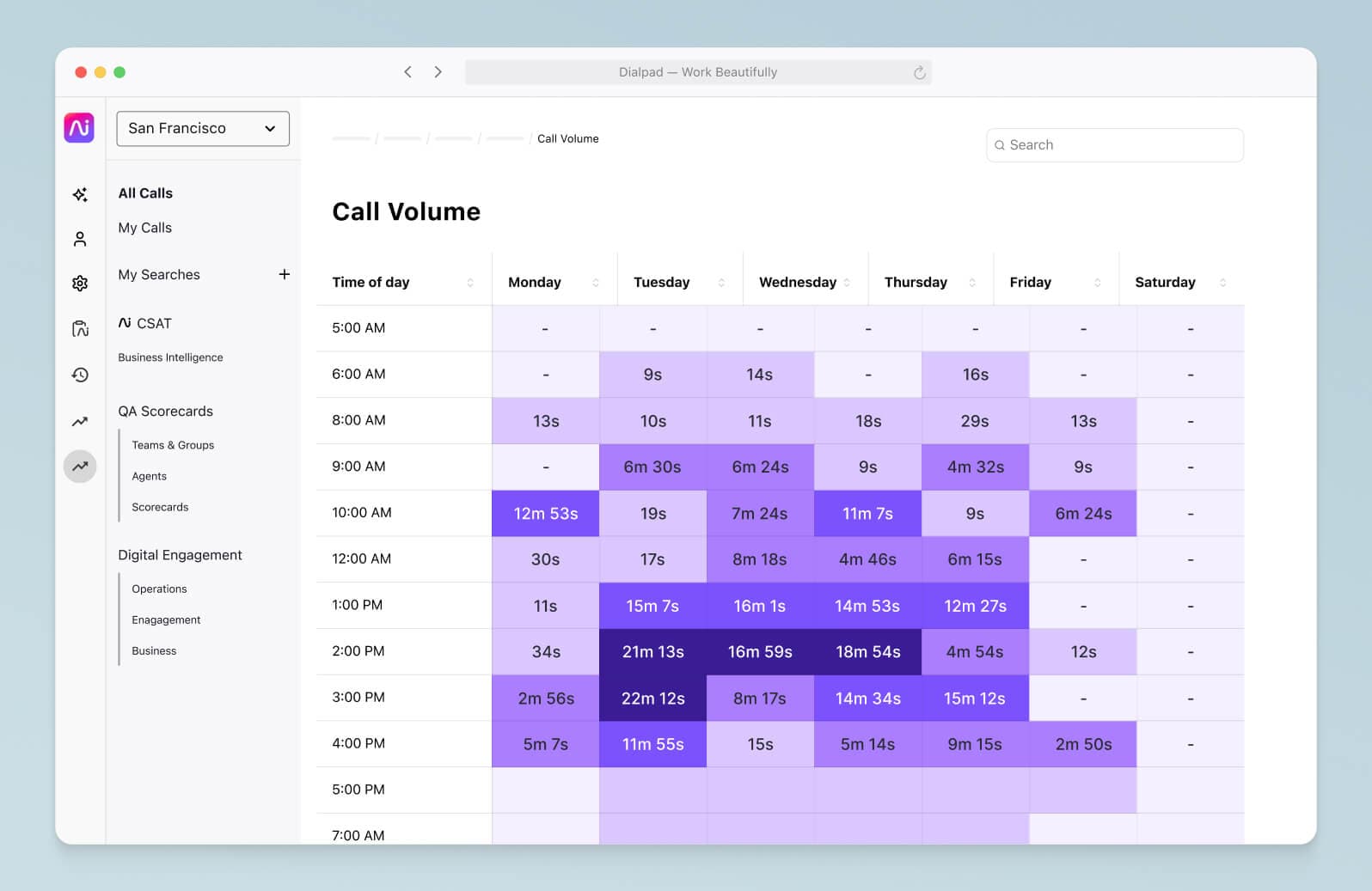
What people overlook: 3 details to pay attention to when shopping for a contact center solution
Is the solution truly integrated?
I don’t mean just native integrations with the other CRMs or business software you’re using (though those are important too)—this is referring to a truly integrated UCaaS and CCa solution.
Not every company might need or be aware of this, but if you do want to streamline your tech stack and not use five or six (or more) different tools when you only need one, then this is important.
Most companies today are using one tool for video conferencing, another for messaging, another separate phone app, and then another contact center platform.
Other companies, which are a little more ahead of the curve, will use one UCaaS solution (that handles all these phone calls, video conferencing, and messaging—but they’ll still have a separate CCaaS solution.
It’s actually possible to have software that integrates both the UCaaS side and CCaaS side into one. It’s rare, but it’s possible. Dialpad is one of the few that does this. (More on this below.)
👉 Look out for…
Providers that are actually reselling or whitelabelling other companies’ software, but claim they unify both UCaas and CCaaS (e.g. RingCentral20 and Nextiva21). This in itself isn’t a “bad” thing, but what tends to happen with these kinds of Frankenstein-ed packages is that the end user will have to log into different accounts, you’ll have two different user experiences, and you may not get customer support as easily for more complex questions because you’ll have to be directed to the original provider whose software is being whitelabelled. Not a dealbreaker for everyone, of course, but something to be aware of.
Does it keep your business or organization compliant?
This is a pretty straightforward one. For businesses and organizations that are in regulated industries like healthcare or financial services, your contact center platform needs to help you stay compliant with HIPAA, GDPR, and so on.
(See how organizations in those industries are using Dialpad as their contact center platforms: Fenway Health and Camino Financial.)
We’ve seen many customers switch over to Dialpad because they thought that another provider would help them maintain HIPAA compliance, but it didn’t. Make sure your shortlist checks those boxes!
Is it easy to use?
And finally, you’d think this one would be top of mind and not easily missed for people as they’re shopping for contact center solutions, but according to many of our customers and prospects, it’s surprisingly not the case!
That’s partially because it’s not always easy to check what every task in your daily workflow might look like in that solution. Also, there are always those little buggy inconveniences that seem like they’re not a big deal in a demo—but when you have to do them regularly, those little inconveniences end up being big productivity-killers.
For example: Adding agents and removing agents, or adding or managing phone numbers for new hires.
Traditionally, it took time—days or weeks—to make those changes to a contact center account. Want to add agents to different departments? Remove agents after high season is over? What about adding a phone number for a new agent? Those were often not easy, or not possible, to do on your own. Not anymore.
In fact, Mike, the Communications System Manager at EF Education First (with over 10,000 employees!), says that "With Dialpad, we can set up a new call center in 10 minutes from anywhere. We have the flexibility to manage our call center on our own, and it’s easy.”
As a quick example, here’s what adding a phone number looks like in your online dashboard in Dialpad. Literally just a few clicks and a few minutes of your time:

Provide a better customer experience with an easy-to-use cloud-based contact center solution
If you want a fully customizable contact center solution, or have the IT resources to support it, there are definitely options that give you that 100% control, like Twilio Flex.
If you want a fully on-premises solution, there are PBX-focused solutions for that too, like Avaya.
But if you just want something that’s easy to use and quick to set up, you should at least check out Dialpad Ai Contact Center. It’s easy to admin from anywhere, integrates with a range of different tools to give you full WFM/QM functionality, and also has 24/7 customer support—without charging extra.
Whether you want to better understand and manage your customer interactions or close more deals, Dialpad can help with that!
Need contact center software?
Book a demo to see how easy it can be to set up and use Dialpad’s contact center solution, or take a self-guided interactive tour of the app first!
1gartner.com/reviews/market/contact-center-as-a-service/vendor/talkdesk/product/talkdesk
2talkdesk.com/pricing/
3g2.com/products/aircall/reviews
4aircall.io/pricing/
5g2.com/products/five9/reviews
6five9.com/products/pricing
7getvoip.com/reviews/avaya/#reviews
8avaya.com/en/ca/products/ccaas-pricing/
9g2.com/products/freshdesk/reviews
10pcmag.com/reviews/freshdesk
11g2.com/products/twilio-twilio-flex/reviews
12twilio.com/flex#pricing
13, 14liveagent.com/pricing/
15vonage.com/contact-centers/plans/
16, 17goto.com/pricing/connect
18cloudtalk.io/pricing/
19ujet.cx/shop
20channelfutures.com/telephony-uc-collaboration/ringcentral-nice-extend-partnership-to-offer-ringcentral-contact-center
21talkingpointz.com/nextiva-competing-around-the-customer-experience/









